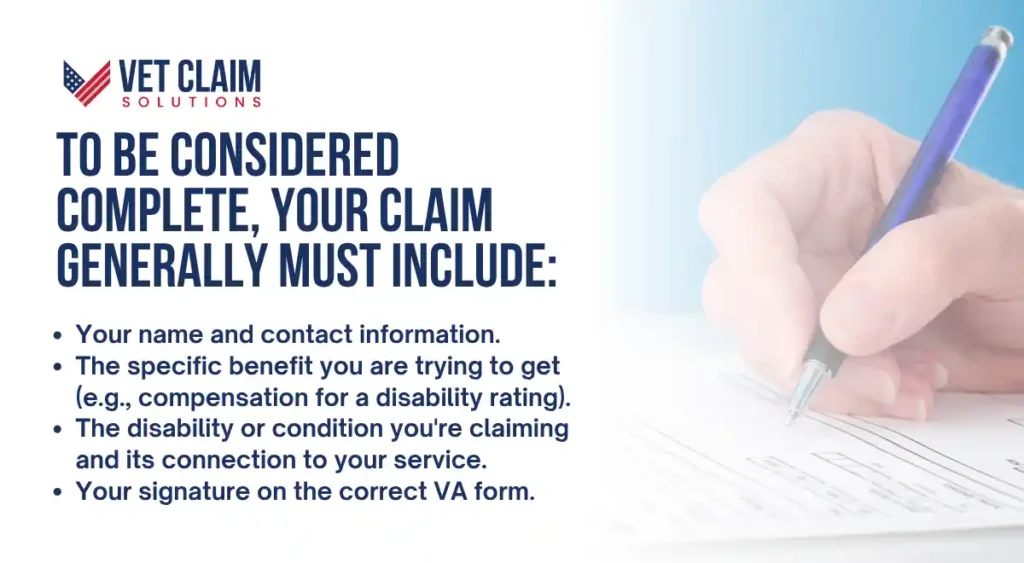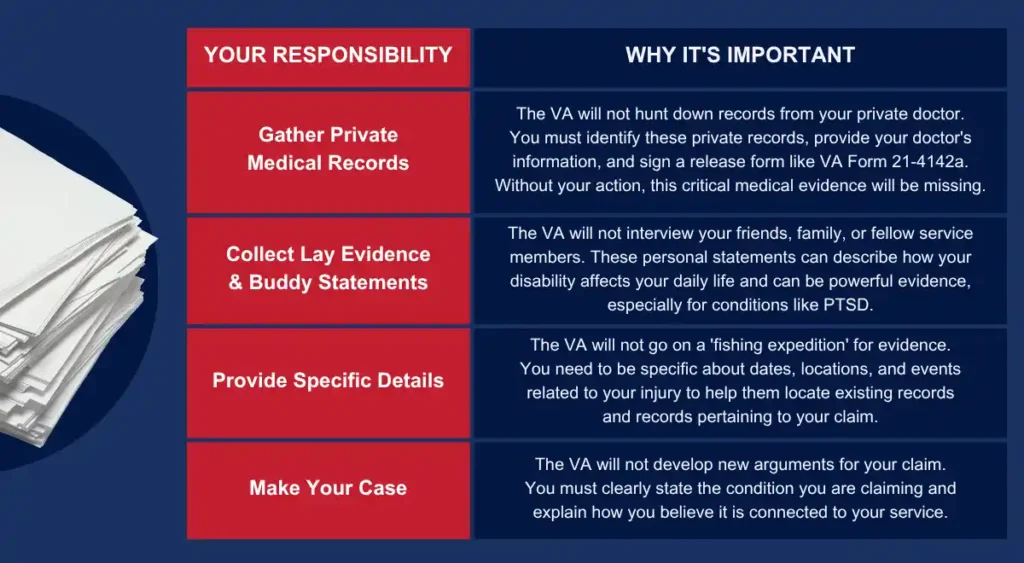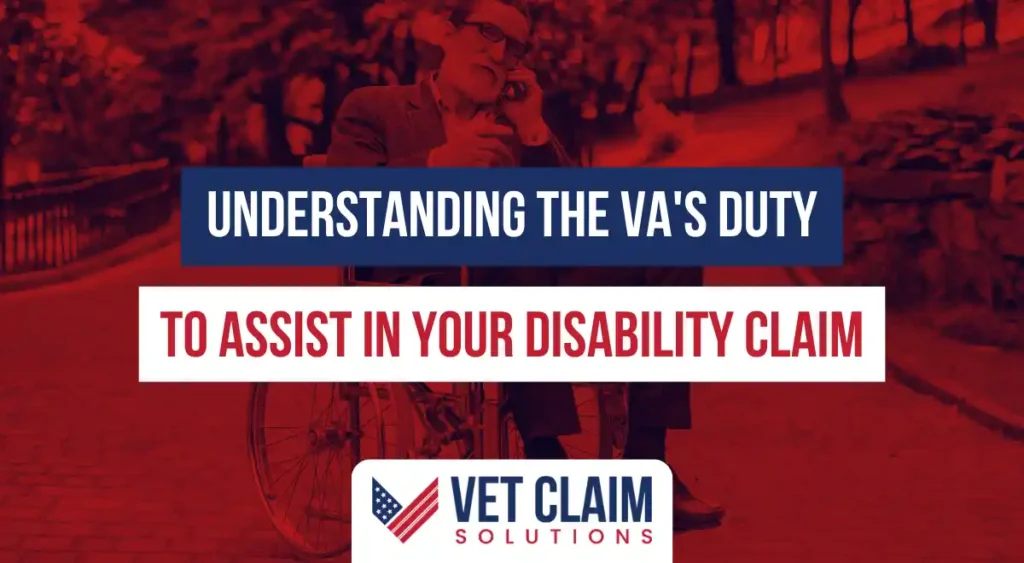You feel like you’re doing everything right. You fill out the VA forms for your disability claim, you submit it, and then you wait. The waiting is often the hardest part, making you wonder if you’re fighting this battle alone.
You are not wrong to feel that way, but you need to know about a powerful rule on your side. It is called the Duty to Assist, which means the Department of Veterans Affairs is legally required to help you prove your case. The VA must help you—but don’t wait on them. Learn what the duty to assist includes and what you still need to do.
This is not just about the VA being helpful; it is a legal obligation that can make a huge difference in your VA claim. But this VA duty has its limits and does not mean you can sit back and expect them to do all the work. It is a team effort, and you are the most valuable player in securing your VA benefits.

What Exactly Is the VA Duty to Assist?
The Duty to Assist is not some vague VA policy; it is the law. This legal requirement was established by the Veterans Claims Assistance Act of 2000 (VCAA). Congress passed this important piece of veterans law to make the process more collaborative and less of a fight.
Before the VCAA, the burden of proof was almost entirely on the veteran, requiring you to find every single piece of evidence to support. The Act changed that by placing a legal responsibility on Veterans Affairs to make “reasonable efforts” to help you gather evidence. This shift fundamentally altered the dynamic of VA claims.
So, what does “reasonable efforts” actually mean? It means the VA cannot just deny your claim because a single document with relevant evidence is missing. They must first try to find it, making them a partner in your claim rather than just a judge.
When Does the VA’s Duty to Help Begin?
This is a critical question with a specific answer. The VA’s duty to help does not start the moment you think about filing. It is triggered when you file what the VA considers a “complete initial claim.”
A complete claim, often called a “substantially complete” claim, provides the VA with enough information to begin work. While it seems simple, missing a piece can cause significant delays in your journey to get VA disability. A complete initial claim is the first step in receiving veterans claims assistance from the VA.

Once the VA has this basic information, their legal responsibility to assist claimants kicks in. If you submit a claim that is missing one of these key pieces, the VA will likely send it back. They will ask you to provide the missing evidence or information before they can start working on it, which is why being thorough from the start is so important.
The VA Must Help You—But Don’t Wait On Them. Learn What the Duty to Assist Includes and What You Still Need To Do.
This is where we get into the details. Understanding this balance is the key to building a stronger case. The Duty to Assist is a powerful tool, but it is not a magic wand that does everything for you.
What the VA Is Required to Do For You
After you have filed a complete claim, the VA has a checklist of things it must do to help you gather evidence. They will actively try to obtain certain types of records on your behalf. This is a core part of the va’s duty.
The VA will make reasonable efforts to gather:
- Your official military service records, such as your DD-214, which prove your service details.
- Your service medical records, sometimes called SMRs, from your time in service.
- Any relevant federal records from other government departments, like the Social Security Administration if you also receive their disability benefits. The process of obtaining federal records is something the VA handles.
- Medical records from any VA medical center or clinic where you have received treatment, including all VA medical records.
The VA is also supposed to schedule a medical examination, known as a Compensation and Pension (C&P) exam. This happens when they need more medical evidence to make a VA decision. The medical exam is typically used to confirm a diagnosis or to provide an opinion connecting your condition to your military service, and it is one of the most important ways the VA assists you.
What the VA Will Not Do (This Part Is On You)
This is the side of the coin many veterans do not know about, and it can be a source of great frustration. There are many things the VA is not responsible for, and waiting for them to handle these tasks can cause major delays or even a denial. It is essential to understand what you still need to do.
Here’s a breakdown of the responsibilities that fall on you:

Think of it like building a house. The VA will help you gather some of the big materials, like the lumber and foundation, through their records requests. But you are the architect; you must provide the blueprint and gather all the detailed finishing pieces that make the house complete.
Common Pitfalls and Why You Can’t Rely on the VA Alone
Even with the Duty to Assist in place, things can go wrong. It is important to understand the practical realities of the VA claims system. The system is run by people, and people are not perfect, so assist errors can and do happen.
Sometimes, the VA’s effort is not enough. They might send a single initial request to a doctor’s office for private medical records. If they do not receive a reply, they may consider their duty fulfilled and move on without making a follow-up request, which does not help you get your benefits.
Records also get lost or destroyed. You have probably heard stories about the devastating 1973 fire at the National Personnel Records Center. That fire destroyed millions of official military records. In such cases, the VA may not be able to find service records that simply no longer exist, making your own records and buddy statements even more crucial.

Finally, remember that VA raters are handling hundreds of claims and work under immense pressure. If your evidence is not clearly organized and easy to find, something important could be overlooked. Do not leave it to chance; being organized can have a huge impact on your VA decision.
Taking Control of Your Claim
You are your own best advocate. No one knows your story better than you do. Taking control of your claim from the very beginning is the best strategy for success.
Be Proactive with Evidence Gathering
Do not wait for the VA. Start gathering your evidence before you even file your initial claim. This proactive approach puts you in a much stronger position and speeds up the entire process.
Get copies of everything. Go to your private doctor and get your treatment records yourself. Contact friends from your unit and ask if they would be willing to write a statement for you. Doing this early means you are not scrambling later and can review everything for accuracy before submitting it.
Be Specific and Organized
When you fill out your claim forms, be as specific as possible. Do not assume the VA rater knows what you mean. Provide full names, complete addresses, and exact dates whenever you can.
Keep a copy of every single document you send to the VA. It is a good idea to create a folder on your computer or a physical binder for your claim. This keeps everything in one place and protects you if something gets lost in the mail or within the VA’s system.
The Power of Buddy Letters and Lay Statements
Never underestimate the power of a personal story. Medical records provide clinical facts, but buddy letters and lay statements give the context. They can paint a vivid picture of your daily life.
These statements can show how your tinnitus makes it hard to sleep or how your back pain prevents you from playing with your children. This is powerful evidence that can fill in the gaps that medical jargon leaves out. These are details the VA cannot get without your active participation in your claim.

What if the VA Fails its Duty to Assist?
So, what happens if the VA simply does not do its job correctly? This is called a “duty-to-assist error,” and it can be a valid reason to appeal a denied claim. The appeals improvement and modernization act provides several avenues to address these issues.
If your claim is denied, one of the first things you should do is review the VA’s actions. Did they make reasonable efforts to get the records you identified? Did they schedule a C&P exam when one was needed? If they failed in their duty, you may have a strong case for a decision review.
There are a few decision review option paths you can take. You could file a supplemental claim with new evidence pointing out the error. You could also request a higher-level review, where a more senior reviewer looks for errors in how the initial claim was processed. A successful appeal on these grounds often results in a “remand,” meaning the Board of Veterans’ Appeals (BVA) sends the claim back to the regional office with orders to fix the error.
While a remand is not a final victory, it gives your claim another chance. It forces the VA to do the work they should have done the first time around. Identifying a duty-to-assist error can be a critical step in turning a denial into an approval, whether through a supplemental claim, a higher-level review, or a full Board appeal.
Conclusion
The VA’s Duty to Assist is a critical part of the veterans claims process. It confirms that you are not in this alone and that the VA has a legal obligation to help you. However, you cannot afford to be a passive player in your own claim for the benefits you have earned.
You have to be proactive, organized, and the driving force behind your claim. Understanding this balance is everything. Knowing the VA must help you—but don’t wait on them. Learning what the duty to assist includes and what you still need to do, gives you a real advantage.
By taking charge, gathering your own evidence, and guiding the VA, you can build a stronger, more complete claim that has a much better chance of success. Your active participation is the most important factor in a positive outcome.


